When it comes to marketing, there are a lot of terms and concepts that can be confusing. Two of these terms are ‘sales funnel’ and ‘landing page’. Unfortunately, many people don’t know the fundamental difference between the two, so they end up using them interchangeably.
The difference between a sales funnel and a landing page is that a landing page captures leads, while a sales funnel converts leads into customers. A landing page is a standalone page aimed at getting contact information. A sales funnel is a series of conversion-focused steps that a customer takes.
The differences might seem small, but they are quite significant. This post will expand on the difference between sales funnels and landing pages and help you decide which one is right for your business. You may even decide that you need both!
Understanding The Sales Funnel
The first step to understanding the sales funnel is understanding what they are, their purposes, and how they can be used.
You can also understand how a sales funnel works through my in-depth article on the same.
1. The Marketing Definition of a Sales Funnel
A sales funnel is a visual representation of the steps a customer takes to purchase a product or service.
It shows the number of potential customers who enter the funnel at each step and how many of them make it to the next step.
This narrowing process continues until they reach the final conversion point.
There are many different types of sales funnels, but the most common one is the four-stage funnel.
2. The Purpose of a Sales Funnel
The purpose of a sales funnel is to track the progress of potential customers as they progress through the buying process.
It allows businesses to identify which steps need to be improved in order to increase overall conversion rates.
I’ve written a guide on tracking your sales funnel where you can learn how to do it for yourself.
3. Four Stages of a Sales Funnel – The AIDA Model
The four stages of a sales funnel are awareness, interest, decision, and action.
Awareness
The first stage of the funnel is called ‘awareness’. In this stage, the customer is just becoming aware of your product or service.
At this stage, the point of focus is to get the customer’s attention and introduce them to your product.
Interest
The second stage of the funnel is called ‘interest’. Here, the customer becomes interested in learning more about your product.
This stage aims to educate and persuade the customer to buy your product.
Decision
The third stage of the funnel is called ‘decision’. In this stage, the customer has decided to buy your product.
The goal of this stage is to get the customer to purchase your product.
Action
The fourth and final stage of the funnel is called ‘action’. Here, the customer has already purchased your product.
This stage aims to ensure that they are satisfied with their purchase. If this stage is successful, the customer will be encouraged to buy again in the future.
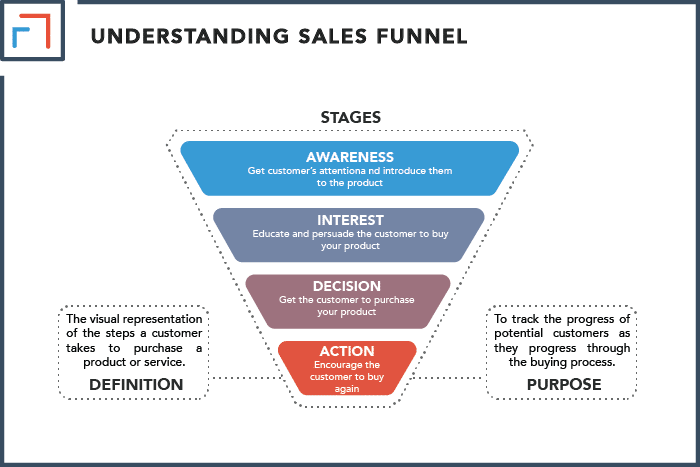
Examples of Sales Funnels in Action
When you’re looking to improve your sales process, it’s essential to look at what’s currently working well for others.
By seeing how other businesses operate, you can get ideas for what might work well for your own business.
In this section, we’ll take a look at some examples of sales funnels in action.
I’ve also covered some of the best sales funnels I’ve come across over the years in my article: Best Sales Funnels Examples.
1. A Low-Price Funnel
In our first example, the business is using a low-price funnel to attract new customers.
This marketing technique aims to get people interested and convert them into paying members by building trust and credibility along the way.
To do this, the business offers a low price for the product in order to get people interested.
They then use marketing and sales tactics (such as social media ads or television commercials) to make conversions.
If you’re looking for a way to attract more low-price customers, a low-price funnel might be a good funnel to emulate.
2. A Free Trial Funnel
In our second example, the business is using a free trial funnel to attract new customers.
The free trial funnel is an excellent way to reel in new leads and convert them into paying customers.
This strategy works well because it gets people interested before they’ve made up their minds about whether or not the product will work for them.
This, in turn, gives you more chances at converting potential buyers. To do this, the business offers a free trial for the product in order to get people interested.
Then they try to convert new customers by using marketing and sales tactics.
With this model, there is no long-term commitment needed from either party because everything can easily be canceled at any time without obligation.
Customers won’t feel pressured to buy immediately, which will give you time to build trust and showcase your product.
If you’re looking for a way to attract more free trial customers, it may be best to use a free trial funnel.
3. A Content Marketing Funnel
For the third example, the business is using a content marketing funnel to attract new customers.
The content marketing funnel is a great way to get people interested in your product and increase brand awareness.
This strategy works well because it provides potential customers with valuable information that they can use to make informed decisions.
To do this, the business creates content that is relevant to its product.
They then use marketing and sales tactics (such as social media posts or email newsletters) to get people interested in their product.
With this funnel, the business is providing potential customers with valuable information that they can use to make informed decisions.
So if you’re looking for a way to increase brand awareness and attract more potential customers, a content marketing funnel may be the right choice for you.
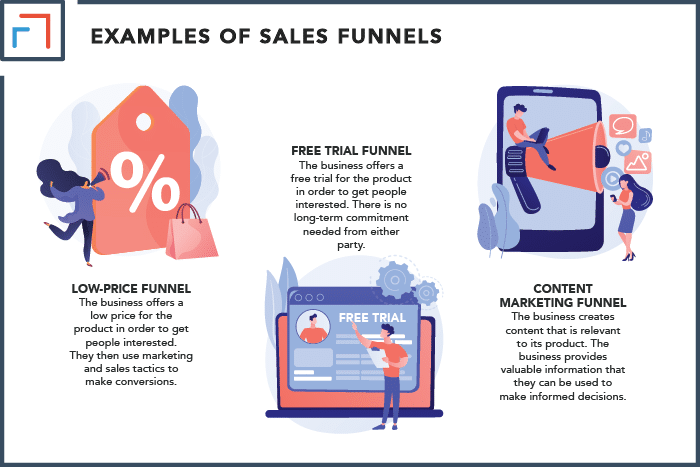
Understanding A Landing Page
We can understand a landing page much better by comparing it against the same parameters used to explain the sales funnel.
1. The Marketing Definition of a Landing Page
A landing page (also known as a lead capture page) is a standalone web page that visitors land on after clicking on an advertisement or a link.
Landing pages can also contain a form where visitors can provide their contact information, such as their name and email address.
They will receive more information, offers, and promotions about the product or service in exchange for this information.
2. The Purpose of a Landing Page
The primary purpose of a landing page is to provide information, take an action, and convert visitors into leads if possible.
However, landing pages can also be used to generate traffic for a website, build an email list, and sell products or services.
3. The Elements of a Landing Page
A typical landing page contains the following elements: headline, sub headline, introduction, body copy, call to action, and contact information.
Let’s look at each of these individually:
- The headline is the first thing the visitor will see, and it should be attention-grabbing.
- The sub headline is a brief statement that elaborates on the headline.
- The introduction is a brief description of the offer. It should briefly introduce the product or service and explain what the visitor needs to do to receive more information.
- The body copy is the main section of the landing page where the visitor will learn more about the offer.
- The call to action is the button or link that the visitor must click on to receive the offer.
- And finally, contact information is where the visitor can find out more about the offer and submit their contact information.
4. The Five Types of Landing Pages
There are five common types of landing pages: simple information, lead capture, click-through, download, and sales. Let’s take a look at each one of these formats.
Simple Information Landing Pages
A perfect example of a simple information landing page is this article you are reading.
You might have landed on our page through a search engine like Google or Bing or a shared link on social media, will read the information, and either go back or visit other pages.
Pro-tip: We highly recommend reading other articles and promise they’re worth your time!
Lead Capture Landing Pages
A lead capture landing page is the most common type of landing page. It’s designed to collect contact information from the visitor in order to generate leads.
Click-Through Landing Pages
A click-through landing page is designed to encourage the visitor to click on a link or an advertisement.
The goal is to send the visitor to another page (such as the website’s home page) for more information.
Download Landing Pages
A download landing page is designed to encourage the visitor to download a file. This might be something like an ebook or a white paper.
Sales Landing Pages
A sales landing page is designed to encourage the visitor to buy a product or service.
It usually contains more information about the product or service, such as images, videos, and customer testimonials.
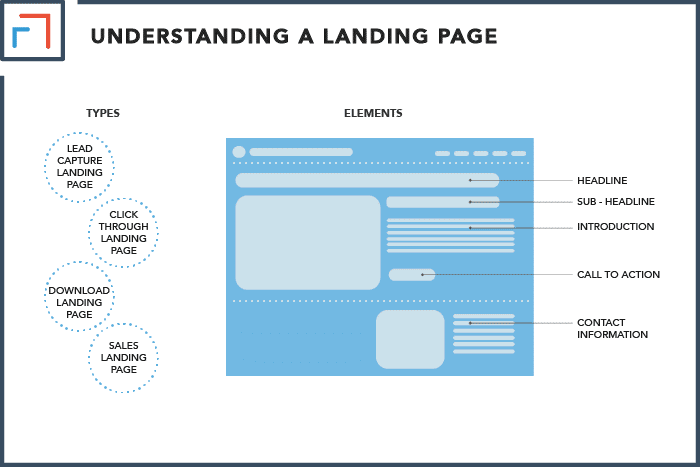
Examples of Landing Pages in Action
When it comes to understanding landing pages, examples are crucial.
So let’s look at three different types of businesses and the corresponding landing pages they might use.
1. Our Local Restaurant
Our first hypothetical business is a small, local restaurant. When someone visits the website, they’re likely looking for information such as the menu, location, or hours.
The restaurant’s landing page would likely be a simple one that features an image of the food and maybe a short blurb about what the restaurant is all about.
In addition, there would likely be a link to the menu, location information, and hours of operation.
2. An Online Retailer
The second business is a giant online retailer. When someone visits the website, they’re likely looking for information on items they can purchase.
To suit this need, the retailer’s landing page would likely be a product listing page that features images of the items, a brief description, and pricing information for each one.
There would also be a link to a more detailed page about the product and a way to add the item to a shopping cart.
3. Software as a Service (SaaS)
The third business is a SaaS (software as a service) company.
When someone visits the website, they’re likely looking for information on how the product works and whether it’s a good fit for their business.
The SaaS company’s landing page would likely be a demonstration video or slideshow that explains how the product works and what it can do for the customer.
In addition, there would likely be a link to a pricing page and a way to sign up for a free trial.
Sales Funnels and Landing Pages – Differences and Similarities
Now that you have a basic understanding of what sales funnels and landing pages are, let’s look at how landing pages differ from sales funnels and some features they both have in common.
In order to understand the differences between the two, we must first define the difference between leads and actual customers.
A lead is someone who has expressed interest in your product or service, but they have not yet made the purchase. A customer is someone who has already purchased your product or service.
| POINT OF DIFFERENCE | SALES FUNNEL | LANDING PAGE |
|---|---|---|
| What is it? | A sales funnel is a complete strategic process with multiple stages. | A landing page is a standalone web page. |
| Objective | Convert leads into customers, buy your product or service. | Capture leads, read information, visit other pages, or click desired links, etc. i.e. take a specific action. |
| Scope | Sales funnel is the parent structure. | Landing pages are a part of the sales funnel, therefore, it is a child structure. A sales funnel can have several landing pages. |
| Intended Use | Perform multiple actions within the funnel. | Take a single action after achieving page objective. |
| Implementation Difficulty | Much more complex than a simple landing page. | Usually simple and easy to create. |
Sales funnels use landing pages as part of their overall strategy, thus, they are not one and the same.
A landing page can also be used to generate traffic for a website, build an email list, and sell products or services.
Since the goal of a funnel is to persuade the lead to buy your product or service, you usually need multiple pages to do that.
Both sales funnels and landing pages can be used to collect contact information from potential customers.
Here is a table listing some commonalities between the two:
| COMMON POINTS | |
|---|---|
| Generation of Traffic | Paid ads, organic traffic, social media, word of mouth. |
| By-product | Builds a relationship with the visitor. |
| Best Result | Visitor performs the desired action. |
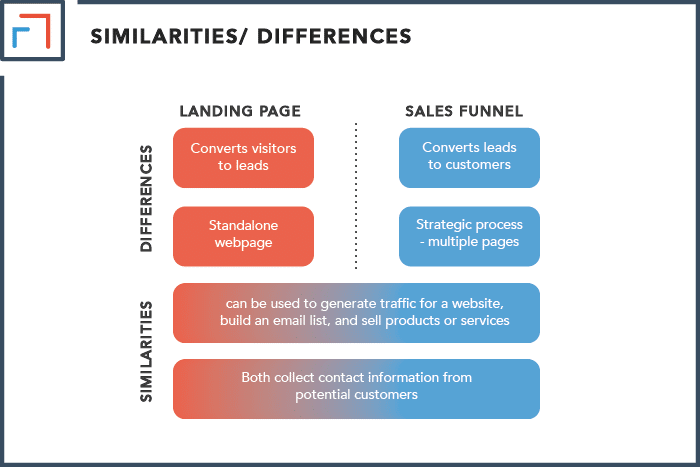
Sales Funnel vs Landing Page: What to Use and When?
Use a landing page if your goal is to generate traffic for your website, simply capture leads, and provide and collect information. Use a sales funnel when your goal is to convert leads into customers and sell products or services. Compared to landing pages, sales funnels are better at converting.
Landing pages are great for collecting information like name and email address.
Once you have that information, you can build a relationship with the lead and eventually convert them into customers.
Landing pages are also great for directing traffic to a specific place.
The reason why a sales funnel is the perfect marketing tool is because it’s designed to persuade the lead to buy your product or service.
A landing page can be used to generate traffic and sell products or services, but a sales funnel is better at converting leads into customers.
If you’re not sure what to do, use a landing page as a starting point.
Landing pages are simple and easy to create, while sales funnels can be more complex.
So, it is always safe to create a landing page when you’re not sure what your end goal is.
Sales funnels and landing pages are both essential components of any effective marketing strategy.
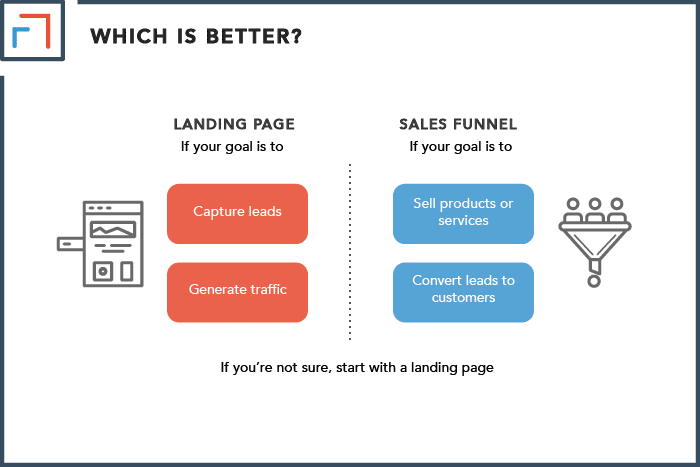
Landing Pages Can Be a Part of Your Sales Funnel
Sales funnels and landing pages are used for very different purposes and have different goals.
They both have their own unique benefits, but the best one for you depends on your specific goals.
So, before you decide which one to use, make sure to define your goals and determine which tool is better suited for achieving them.
